Invention • Function • Art
By Ben Rapaport
To open, tobacco was native to the Americas as early as 6,000 B.C. The uninterrupted consumption of tobacco in a variety of forms in almost every corner of the civilized world for more than 400 years—the custom of pipe smoking is at least that old—spawned a plethora of necessary devices, utensils, accoutrements, and accessories for smoking, maintenance, storage, and transportation that have enriched our lives. This remarkable range of artful objects now bears evidence to the importance that smoking has had for many millions. In the aggregate, they represent a microcosmic insight into a once elegant and glamorous past and, in the present, they are objects of collectibility in their own right. On occasion, one can learn about the people who made them.
One of these utensils is the tobacco pipe. Almost 150 years ago E. R. Billings opined: “Of all the various branches of the subject of tobacco, that of the history of pipes is one of the most interesting, and one that deserves every attention that can possibly be given. Whether considered ethnographically, historically, geographically, or archaeologically, pipes present food for speculation and research of at least equal importance to any other set of objects that can be brought forward” (Tobacco, 1875, 138). And as W.A. Penn explains: “Though pipes are fashioned from such materials as wood, stone, bronze, iron, and other metals, clay, china, asbestos, horn, and other vegetable and mineral products, pipes of clay, meerschaum, and wood form the overwhelming majority” (The Soverane Herbe, 1901, 164). Collecting them has been an avocation dating as far back as the many notables who acquired them, such as New York tobacconist Pierre Lorillard (1742–1776), Duc de Richelieu (1766–1822), Duke of Sussex (1773–1843), Old Hickory, Andrew Jackson (1767–1845), and a few whose names may be more familiar, such as King Farouk, Edward G. Robinson, and Bing Crosby.
This is their story, a mini-history of how man using machine tools manipulated assorted materials to create some exquisitely carved and molded devices, advancing a utilitarian utensil into an art form that is now valued for its workmanship and ingenuity, not its smokability.
Chronologically, the simple clay pipe appeared in England in the late 1500s. The great age of the pipe started in the Eighteenth Century on the continent when it began to exhibit artistic qualities in fanciful forms conspiring with functionality. Porcelain and wood pipes were produced almost simultaneously in Germany and France in the mid- to late 1700s, and the meerschaum in Austria-Hungary around 1725, followed by factories in France, Italy, England, and the United States a century later. These were the four principal mediums, and Europe’s production far exceeded that of the United States. The briar made its appearance in France around 1850, and our American contribution, the corncob, made its debut after the Civil War.
Inspiration and ideas for the turner, carver, molder, and painter came from everywhere: victory and defeat in battle; the birth, marriage, and death of royalty; mythology; heroes and heroines; the hunt; art, music and literature; political figures, luminaries and celebrities; landmarks; the trades and professions; religion; fairy tales and legends; and ordinary life. Other subject matter included the humorous, the metamorphic, the suggestive, erotic, pornographic, and scatological. Left alone to cogitate, the artisan was limited only by his own imagination, creativity, and skill. Pipes were made for smoking, not savored or relished as a future art form.
Artful Mediums for Pipes
Wood
As to the craftsmanship of wood pipes, the marvels of dexterity and skill from, first, the wood-turner and, later, the pipe carver were products of wood-carving centers in Germany, France, Austria-Hungary and, to a much less extent, the Netherlands and Scandinavia. History tells that in the early years, wood-turners experimented with 29 different woods—some fragrant—choosing those that were locally abundant; would sustain the heat of burning tobacco without cracking or splitting (hardness); ease of turning, carving and polishing; appearance; tactility; and smoking ability, wood that would not produce a foul smell or taste. The popular survivors were alder, birch, boxwood, cherry, maple, oak, pear, and walnut. For about 100 years, craftsmen produced a wide variety of three-dimensional wood pipes in various shapes, sizes, and motifs, both the beautiful and the bizarre.
Meerschaum—literally, “sea foam” in German—is hydrated magnesium silicate, a soft, claylike mineral mined principally in Eski?ehir, Turkey. In the early 1900s, deposits were found in New Mexico, but in insufficient quantities to be commercially useful. Unfortunately, this mineral is often misunderstood, even today. It’s not, as Tinder Box International, the retail tobacco and pipe store chain, asserts: “The mineral itself is the fossilized shells of tiny sea creatures that fell to the ocean floor over 50 million years ago, there to be covered and compressed over the ages by layer upon layer of silt.” Nor is it, as posted on Wikipedia, “… sometimes found floating on the Black Sea,” or the compressed whitecaps of waves. It’s neither a major industrial mineral nor a precious stone, but it retains a record of a long and continuing association with art and the personal affairs of man. Meerschaum was found to be an ideal medium for fashioning small objects. It has a rather exotic and enchanting ring. It is a poetic figure of speech, described as the aristocrat of smoking pipes; the queen of pipes; Venus of the Sea; White Goddess; soft and light as a fleeting dream; creamy, delicate, and sweet as the complexion of young maidenhood; one of the choicest and rarest gifts of the gods; the “apple of the eye” of the refined pipe smoker. Strange, though, that this word whose origin is somewhat obscure, yet in universal use for more than 250 years, has never been translated into English and there is no English-equivalent word.
Often, these pipes, and their diminutive counterparts, the cheroot (a small, cylindrical cigar) holders have surpassed ordinary creativity and craftsmanship and verge on artistic genius, to be compared with larger-than-life creations in bronze, marble, alabaster, and stone of, say, Brancusi, Cellini, Maillol, Moore, and Saint-Gaudens. “To make a valuable, carefully-worked meerschaum required erudition in the applied arts,” remarked Anna Ridovics, art historian at the National Museum of Hungary, Budapest.
Porcelain
Hard-paste and soft-paste porcelain pipes were produced in both France and Germany, the latter having been more prolific and inventive for many more years than the former. Here is how one writer described the porcelain pipe: “The latter are beautifully ornamented with landscapes, with pictures of the ruins of Germany, with copies of celebrated paintings, or with miniatures of warriors, statesmen, poets, and professors. They are not unfrequently executed with great beauty, and the colours being burned in, remain indelible … They are ornamented with a gold or silver cord, and with two tassels of the same material beautifully braided; and thus adorned, cost from one to forty dollars” (Henry E. Dwight, Travels in The North of Germany, in The Years 1825 and 1826; 1829, 47). Many experts, however, called the porcelain a tongue-burner, a dreadful smoke, a fetid cauldron, and a perambulating chimney, because porcelain does not breathe.
Just as most meerschaum carver names are not known, those who molded, finished, and painted porcelain pipe bowls are nameless, but the factories in which they worked are familiar to those who collect fine china: Hutschenreuther, Meissen, Nymphenburg, Sèvres, and several others. The industry prevailed for about two centuries, but the porcelain pipe swam against the tide of the then-current tastes. It struggled to coexist with two more popular mediums: some relished smoking the simple, low-cost clay, while others savored the taste and allure of the complex and intricately carved meerschaum.
Other
Some pipes were occasionally made in amber, bone, ivory, precious metal, even glass, and they exhibited the general and conforming shape of a tobacco pipe. None of these materials could sustain heat, so they were not well received by smokers. However, these pipe oddities were charming in their own right: very unusual configurations, unconventional or odd materials, utensils that may not look like pipes but were … and contrivances that looked like pipes that really weren’t. Glass pipes from England and Italy, for example, were the expressions of idle time and idle hands in glass factories and were sold as fairings—trinkets—at county fairs. The smoking implements native to aboriginal cultures—ethnographic pipes—using human, animal or fowl bones, seashells, and fibrous materials belong to this group.
In pursuit of a more information? I suggest the following online articles: “The Porcelain Pipe: A Smoker’s Nightmare, A Collector’s Dream,” and “Collecting Antique Meerschaums—Really Regal Pipes!” (go-star.com), and “A Brief History of Tobacco Pipes & Pipe Collecting” (worldcollectorsnet.com). Three primers on topic are Alfred Dunhill, The Pipe (1924, 1969), Roger Fresco-Corbu, European Pipes (1982), and Jean Rebeyrolles, Collectible Pipes (2002). And for a worldview of fanciful pipes, visit Facebook, “The Tobacco Pipe Artistory,” and tobaccopipeartistory.blogspot.com.
Ben Rapaport is the author of several pipe and tobacco books, four of which are illustrated histories: A Complete Guide to Collecting Antique Pipes (1979); Collecting Antique Meerschaums (1998); The European Porcelain Pipe (2014); and Tobacco and Smoking Among the Blue and Gray. The Illustrated History of An American Folk-Art Curiosity. The Civil War Soldier’s Tobacco Pipe (2014).




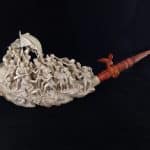
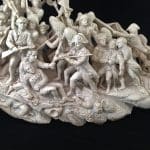


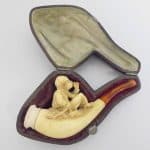
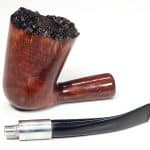



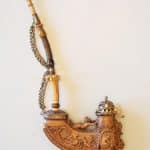


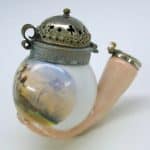
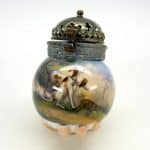



Related posts: